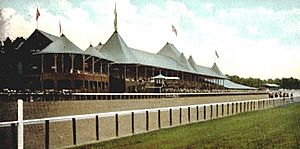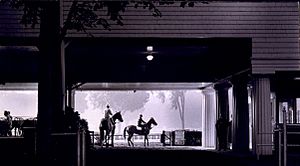Saratoga Race Course facts for kids
 Aerial view of the race course in 2025
|
|
| Location | Saratoga Springs, New York, U.S. |
|---|---|
| Coordinates | 43°04′18″N 73°46′07″W / 43.07167°N 73.76861°W |
| Owned by | State of New York |
| Operated by | New York Racing Association |
| Date opened | August 3, 1863 |
| Screened on | MSG Plus (restricted to cable systems in New York City, Northern/Central New Jersey, Fairfield County, Connecticut, and Northeastern Pennsylvania) Capital OTB via WXXA Channel 23.2) NYRA.com/NYRA Now app (Internet) Altitude Sports (Rocky Mountains) Fox Sports 2 FanDuel Sports Network Ohio FanDuel Sports Network West (Southern California) NBC Sports Network NBC Television |
| Course type | Flat/Thoroughbred |
| Notable races | Travers Stakes (G1) Whitney Handicap (G1) Alabama Stakes (G1) Jockey Club Gold Cup (G1) |
Saratoga Race Course is a famous place in Saratoga Springs, New York. It's where Thoroughbred horse racing happens. This track first opened in 1863. Many people think it's one of the oldest major sports places in the United States. It's actually the fourth oldest racetrack in the country.
The New York Racing Association runs the racetrack. When it first started, the races only lasted for four days. Over time, the racing season got longer. Since 2010, the races happen five days a week. The season runs from mid-July until Labor Day in early September.
Contents
A Look Back: History of the Track
Horse races and shows were happening in Saratoga Springs as early as 1822. In 1847, a track for harness racing was built. This was called the Saratoga Trotting Course. It held its first race on August 14 of that year. This old track was near where the Oklahoma Track is today.
On August 3, 1863, a man named John Morrissey organized the first thoroughbred horse races. These races took place on the Oklahoma Track. After the races were a big success, Morrissey bought more land. He built a new grandstand and named it Saratoga Race Course.
Saratoga Race Course has been used almost every year since 1864. There were only a few times it closed. It closed in 1896 because there were too many other racetracks. It also closed in 1911 and 1912 due to new rules about betting. During World War II, from 1943 to 1945, races were moved. This was because of travel rules during the war.
In the late 1800s, the track faced some tough times. In 1901, a group of investors led by William Collins Whitney bought it. They made many improvements and brought back its good name. The first machines for parimutuel betting were put in place in 1940. In the 1960s, the main seating area was made bigger. This doubled how many people could watch the races.
In 1999, Sports Illustrated magazine called Saratoga Race Course one of the top sports venues of the 20th century. Recently, from 2023 to 2025, the Belmont Stakes races were held at Saratoga. This was because Belmont Park was being renovated.
Famous Upsets: The Graveyard of Champions
Saratoga Race Course has some fun nicknames. People call it The Spa because of the nearby mineral springs. It's also known as the House of Upsets and the Graveyard of Champions. This is because many famous horses have lost races here when they were expected to win.
Here are some of the legendary horses who lost at Saratoga:
- Man o' War lost only one race in his whole career. It happened at Saratoga in 1919. He lost to a horse named Upset.
- Gallant Fox won the Triple Crown in 1930. But he was beaten by a horse named Jim Dandy at Saratoga. Jim Dandy was a huge underdog!
- Secretariat, another Triple Crown winner from 1973, also lost at Saratoga. He was defeated by a horse named Onion.
- Rachel Alexandra, the best horse of 2009, lost a race here in 2010.
- American Pharoah, who won the Triple Crown in 2015, also had an unexpected loss at Saratoga. He was beaten by Keen Ice.
The Race Tracks and Special Features
Saratoga Race Course has three different tracks. These are similar to the other tracks run by the New York Racing Association.
- There's a main dirt track. It's about 1.8 kilometers (1 1/8 miles) around.
- There's a turf (grass) track. It's 1 mile (8 furlongs) around. This track is called the Mellon Turf Course.
- There's also an inner turf track. It's a bit smaller, about 1.4 kilometers (7 furlongs) around.
Steeplechase races, which involve horses jumping over obstacles, also happen on the inner turf course.
Across the street from the main course is the Oklahoma Training Track. This track is used for horses to warm up and train. The very first races in 1863 happened at this location. In 2013, a new viewing stand opened there. It lets people watch the horses train.
The dirt track at Saratoga used to have a special "Wilson Mile chute." This was a side path for certain races. It was removed in 1972 for more parking. But in 2022, the Wilson Mile chute was rebuilt and is now used again.
What Makes Saratoga Unique?
Saratoga Race Course has some special traditions and places.
- Before each race, a bell rings exactly 17 minutes before the start time. This calls the jockeys to the paddock.
- Visitors can get very close to the horses. The path from the stables to the paddock goes right through the picnic areas.
- There's a mineral spring called the Big Red Spring in the picnic grounds. People can drink the water that made Saratoga Springs famous.
- A pretty gazebo stands in the middle of the track. A picture of this gazebo is even part of the Saratoga Race Course logo!
Saratoga Race Course hosts some of the most important races in North America. The Travers Stakes has been run here since 1864. It's the oldest major thoroughbred horse race in the United States. Like the Kentucky Derby, it's for three-year-old horses and has a big prize. Other important races include the Alabama Stakes and the Whitney Stakes.
In recent years, "twilight racing" has become popular. On some days, the first race starts later in the afternoon, around 2:30 PM.
Exciting Races at Saratoga
Many exciting races happen at Saratoga. These are called "Graded Stakes races." They are ranked by how important and competitive they are.
Top Grade I Races
These are the most important races:
- Alabama Stakes
- Ballerina Stakes
- Belmont Stakes
- Coaching Club American Oaks
- Diana Stakes
- Forego Stakes
- Fourstardave Handicap
- H. Allen Jerkens Memorial Stakes
- Hopeful Stakes
- Jockey Club Gold Cup
- Personal Ensign Stakes
- Saratoga Derby
- Spinaway Stakes
- Sword Dancer Stakes
- Test Stakes
- Travers Stakes
- Whitney Stakes
Grade II and Grade III Races
These races are also very important:
- Alfred G. Vanderbilt Handicap
- Amsterdam Stakes
- Ballston Spa Stakes
- Bowling Green Stakes
- Glens Falls Stakes
- Honorable Miss Handicap
- Flower Bowl Stakes
- Jim Dandy Stakes
- Lake George Stakes
- Lake Placid Stakes
- National Museum of Racing Hall of Fame Stakes
- Prioress Stakes
- Saratoga Oaks
- Saratoga Special Stakes
- Shuvee Stakes
- Adirondack Stakes
- Caress Stakes
- Coronation Cup Stakes
- Forbidden Apple Stakes
- Lake George Stakes
- Mahony Stakes
- Quick Call Stakes
- Sanford Stakes
- Saranac Stakes
- Troy Stakes
- With Anticipation Stakes
Steeplechase:
- New York Turf Writers Cup Handicap (Grade I)
- A. P. Smithwick Memorial Handicap (Grade I)
Honoring Champions: Burials at the Track
Some famous horses are buried at the Clare Court Jogging Track. These include Fourstardave, Mourjane (IRE), Quick Call, and A Phenomenon. The champion filly Go For Wand, who was hurt during a race in 1990, is buried in the middle of the Saratoga Race Course.
Saratoga's Impact: Helping the Local Economy
Saratoga Race Course is very important for the local economy of Saratoga Springs. In 2011, a study found that visitors to the track spent between $39 million and $55 million each year. This money was spent on hotels, food, fun, shopping, and travel. The total impact on the area was even higher, between $67 million and $94 million annually.
In 2021, the head of the Saratoga County Chamber of Commerce said the racetrack brings about $240 million to the region every year. The COVID-19 pandemic affected local businesses. This was because no fans were allowed at the races in 2020.
See also
- New York Racing Association
- Aqueduct Racetrack
- Belmont Park
Other reading
- Heller, Bill. Saratoga Tales: Great Horses, Fearless Jockeys, Shocking Upsets and Incredible Blunders at America's Legendary Race Track (2004). Whitston Publishing Company. ISBN: 978-0-87875-551-6.






